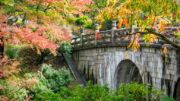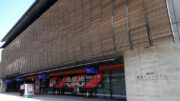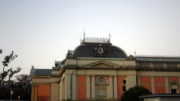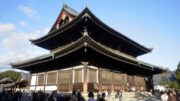Arashiyama, located in the western part of Kyoto, is home to some of the city’s most magnificent parklands and gardens, including the iconic Sagano Bamboo Grove, one of the most recognisable images of Kyoto. The area is beautiful year-round, but the spring cherry blossom season and the autumn foliage period towards the end of the year make it even more special. During these times, tens of thousands flock to Arashiyama to witness the stunning colours.
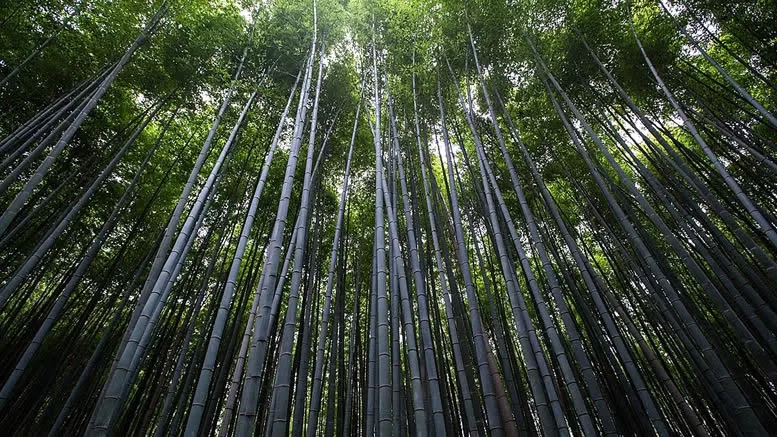
The Sagano Bamboo Grove
The Sagano Bamboo Grove offers an incredible walking experience and is located near the Tenryu-ji Temple, a UNESCO World Heritage Site founded in 1339. A path cuts through the soaring bamboo forest, creating a tunnel-like effect that leads to the entrance of Okochi Sanso Villa, a beautiful residence once owned by Japanese actor Okochi Denjiro. There is an entrance fee for the villa, but it includes a stroll through the large traditional Japanese estate and a complimentary sweet and hot cup of matcha.
Togetsukyo Bridge
Another scenic highlight of Arashiyama is the Togetsukyo Bridge, meaning “Moon Crossing Bridge.” Although rebuilt in the 1930s, its history dates back over a thousand years to the Heian Period. The bridge provides a great vantage point to view the beautiful parklands and forests. For animal lovers, there is a monkey enclosure near the bridge. Here, visitors can explore the Monkey Park Iwatayama and enjoy the company of hundreds of free-roaming macaques, or snow monkeys, that are very friendly.
Saga Toriimoto Preserved Street
Visitors should also explore the Saga Toriimoto Preserved Street, which has been maintained to look as it did over a century ago during the Meiji Period. The street is lined with traditional townhouses, or machiya, some of which have been converted into shops or small restaurants. This street leads to the Adashino Nenbutsu-ji Temple, founded in the 9th century by the monk Kobo Daishi. He is famous for placing stone statues on the souls of the dead, and today, hundreds of these stone statues still remain. A similar sight can be found at the nearby Otagi Nenbutsu-ji Temple, which features 1,200 stone statues of rakan, who were devoted followers of Buddhism. Although they appear ancient, these stone carvings were created only 30 or so years ago, and each statue has a unique expression.
Additional Attractions
- Kimono Forest: Near Arashiyama Station, the “Kimono Forest” is a pathway lined with over 600 pillars filled with colourful kimono textiles. It is illuminated at night, creating a magical atmosphere.
- Saga Scenic Railway: Also known as the Sagano Romantic Train, this sightseeing train runs along the Hozu River, offering breathtaking views of the surrounding landscapes, especially stunning during the cherry blossom and autumn foliage seasons.
- Hozu River Boat Ride: Visitors can take a traditional boat ride down the Hozu River, experiencing the natural beauty of the area from the water. This ride has been popular since the 1600s.
Arashiyama is a place where nature, history, and culture converge, offering a rich and immersive experience for all who visit. Whether strolling through the bamboo groves, admiring the historic bridges, or exploring ancient temples, Arashiyama provides a serene and picturesque escape that captures the essence of Kyoto.
Accessing Arashiyama
Accessing Arashiyama is straightforward and convenient. From Kyoto Station, you can take the JR San-In Line to Saga-Arashiyama Station, which takes about 15 minutes. Alternatively, the Hankyu Arashiyama Line connects Arashiyama with central Kyoto via Katsura Station. For a more scenic route, you can ride the Keifuku Electric Railroad (Randen) from Shijo-Omiya Station to Arashiyama Station. Buses and taxis are also readily available, and for the adventurous, renting a bicycle offers a fun way to explore the area and its surroundings.

